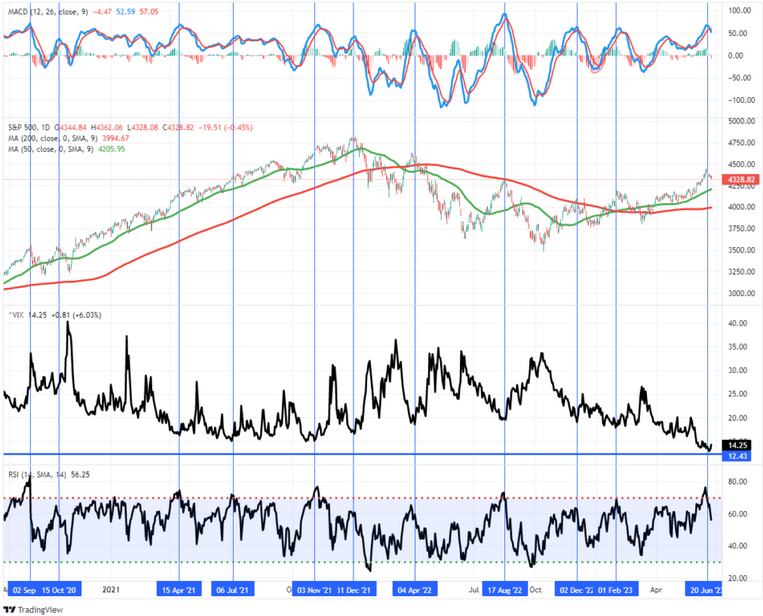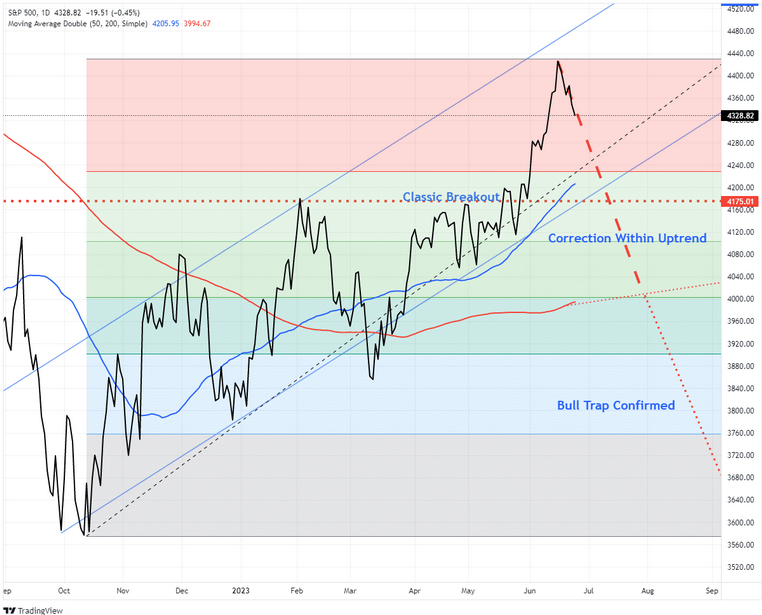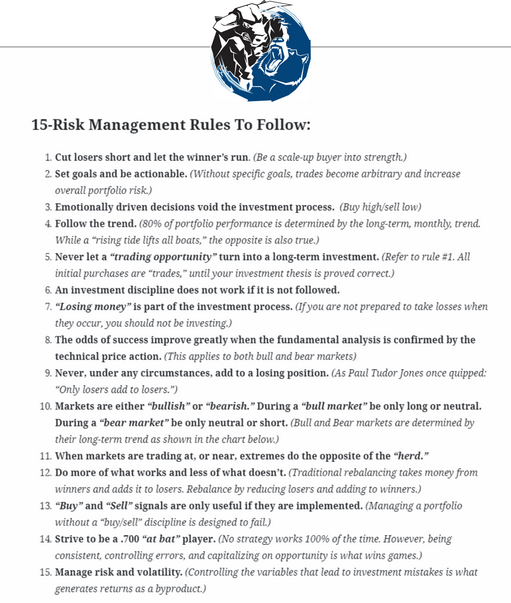This was a question I recently received about the S&P 500 on Twitter. Of course, understanding the term “bull trap” is needed for those not deep into technical analysis.
“A bull trap is a false signal, referring to a declining trend in a stock, index, or other security that reverses after a convincing rally and breaks a prior support level. The move ‘traps’ traders or investors that acted on the buy signal and generate losses on resulting long positions. A bull trap may also refer to a whipsaw pattern.“
An excellent example of a “bull trap” was in June of 2022 when the market rallied 20% and had completed a 50% retracement of the last market decline. The media quickly pushed headlines declaring a “new bull market” had started, and technically there was historical data to support that claim.
“Since WWII, every time the S&P recovered 50% of the bear market price decline, while the 500 may have re-tested the prior low, it never set a lower low,” Sam Stovall, Chief Investment Strategist at CFRA Research
The problem, then, is the bear market was not over, and during the next couple of months, as shown, the market set new lows.

Investors that jumped into the market to chase the rally were caught in a “bull trap,” and hopes for further gains quickly turned to losses.
Once again, the markets are rallying. As prices rise, investors are now jumping into the market, aggressively increasing equity allocations, hoping that recent gains are a clear signal the “bear market is dead.”
As we noted recently, this bullish market rally certainly has a different tenor than what we witnessed in 2022. To wit:
“The difference currently is that the market is trading well above the 200-DMA with a ‘bullish golden cross’ of the 50-DMA above the 200-DMA. The technical backdrop is significantly different than that of 2022 and suggests that stocks will likely continue to trade higher in the coming months.”

Despite the critical technical differences, many individuals still expect the bear market’s return. The presumption is that investors piling into the market this year, particularly into the Technology heavy Nasdaq, are walking into a “bull trap.”
What is certain is that the recent run higher will eventually correct. The question is whether that correction is a resumption of the “bear market,” confirming the “bull trap,” or an opportunity to increase equity allocations as the bullish trend continues.
A Fib-A-What?
As discussed recently, the market reached extreme deviations from key moving averages.
“This past week, the market pushed well past our previous price target and is moving well into 3-standard deviations above the 50-DMA. Furthermore, the market is very overbought on multiple levels. Lastly, the volatility index is at extremely low levels, which has almost uniformly preceded corrections of 5-10% during both bull and bear markets.”

When the correction begins in earnest, the more bearish crowd will denote that the “bull trap” has been sprung and the bear market has returned. However, technically, there is a difference between a correction and a return of the bear market.
To define the difference between a “correction” and the “return of the bear,” we can use a Fibonacci retracement sequence of the rally from the October lows. Let’s start with a definition of a “Fibonacci sequence.”
Leonardo Pisano Bogollo (1170-1250), an Italian mathematician from Pisa, is credited with introducing the Fibonacci sequence to the West. The sequence (0, 1, 1, 2, 3, 5, 8, 13, 21, 34, 55, 89, 144, 233, 377…to infinity) contains many unique mathematical properties. After 0 and 1, each number is the sum of the prior two numbers. A number divided by the previous number approximates 1.618.
1.618 refers to the Golden Ratio or Golden Mean, also called Phi. The inverse of 1.618 is .618 or 61.8%. These ratios are found throughout nature, architecture, art, and biology. The proportion of .618034 to 1 is the mathematical basis for the shape of playing cards, the Parthenon, sunflowers and snail shells, Greek vases, and the spiral galaxies of outer space. The Greeks based much of their art and architecture upon this proportion. They called it the “golden mean.“
What Does That Have To Do With The Market?
“Fibonacci Retracements are ratios used to identify potential reversal levels. These ratios are found in the Fibonacci sequence. The most popular Fibonacci Retracements are 61.8% and 38.2%. Note that 38.2% is often rounded to 38%, and 61.8 is rounded to 62%. After an advance, chartists apply Fibonacci ratios to define retracement levels and forecast the extent of a correction or pullback. Fibonacci Retracements can also be applied after a decline to forecast the length of a counter-trend bounce. These retracements can be combined with other indicators and price patterns to create an overall strategy.”
With this understanding, let’s apply a Fibonacci retracement sequence to the rally from the October lows. If we assume a correction started from the market high on June 14th, 2023, the retracement sequence provides mathematical levels of potential support during a retracement.
A roughly 5% correction would reach the initial 23.6% retracement. At that level, it will likely intersect with the 50-day moving average. The next level of a corrective process would require a 7% decline to the 38.2% retracement and a nearly 10% decline to the 50% retracement to the 200-day moving average.
Notably, in any given year, bullish or bearish, a 5-10% correction is entirely normal and healthy. Such corrective actions are opportunities to increase portfolio equity risk.

However, if the market breaks the 200-day moving average and the 50% retracement level, such would suggest that the recent rally from the October lows is indeed a “bull trap.” Such a violation would change the portfolio management dynamic from “buying dips” back to “selling rallies” and a reduction of overall equity risk.
With the support at the 200-day moving average removed, the next retracement level is 12% lower at 63.8%. The next level is a 15% decline to the 78.6% retracement level. The last leg is a full 100% retracement to the October lows encompassing a 19% decline from the June peak.
Keeping Perspective
In the “heat of the battle,” losing sight of the overall strategy for victory.
When I competed in martial arts, my instructor regularly taught us lessons from the “Art Of War.” He was a Vietnam helicopter pilot that was shot down behind enemy lines. After exhausting his ammunition, he had to fight his way home using primarily hand-to-hand combat. Obviously, we respected his teachings. My favorite was always:
“If you know the enemy and know yourself, you need not fear the result of a hundred battles. If you know yourself but not the enemy, for every victory gained you will also suffer a defeat. If you know neither the enemy nor yourself, you will succumb in every battle.” – Sun Tzu
The same lessons apply to investing. If you can understand the market is volatile and that you are emotional, you can navigate the market. Just as in martial arts, the key to success in battle is controlling “fear” in the face of uncertainty. Does this mean you will win EVERY battle? No. But it does provide a higher probability of victory over defeat.
This is why I regularly publish the rules we follow in our practice. While these rules will not guarantee success, they increase the probability of success over time.

As we have noted, there are undoubtedly many reasons to be “bearish” on the market. However, the market can and often does things that defy logical analysis. Focusing on your investment discipline and ignoring the media-driven narratives that can detract us from our strategy is essential.
If the current market advance is a “bull trap,” we will have enough warning to reduce market risk. If it isn’t a “bull trap,” sitting on the sidelines is just as damaging to portfolio returns.
Such is why some forms of analysis, like retracement levels, can help us navigate unknown or uncharted waters. No analysis, fundamental or technical, will provide results with 100% accuracy. But just as in any conflict, you don’t have to win every battle to win the war.
